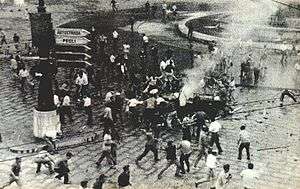Fernando Tambroni
| Fernando Tambroni | |
|---|---|
 | |
| 36th Prime Minister of Italy | |
|
In office 25 March 1960 – 26 July 1960 | |
| President | Giovanni Gronchi |
| Preceded by | Antonio Segni |
| Succeeded by | Amintore Fanfani |
| Italian Minister of the Interior | |
|
In office 6 July 1955 – 15 February 1959 | |
| Prime Minister |
Antonio Segni Adone Zoli Amintore Fanfani |
| Preceded by | Mario Scelba |
| Succeeded by | Antonio Segni |
| Italian Minister of Budget | |
|
In office 15 February 1959 – 26 July 1960 | |
| Prime Minister |
Antonio Segni Himself |
| Preceded by | Giuseppe Medici |
| Succeeded by | Giuseppe Pella |
| Italian Minister of the Treasury | |
|
In office 15 February 1959 – 25 March 1960 | |
| Prime Minister | Antonio Segni |
| Preceded by | Giulio Andreotti |
| Succeeded by | Paolo Emilio Taviani |
| Italian Minister of Merchant Navy | |
|
In office 17 August 1953 – 6 July 1955 | |
| Prime Minister |
Giuseppe Pella Amintore Fanfani Mario Scelba |
| Preceded by | Bernardo Mattarella |
| Succeeded by | Gennaro Cassiani |
| Personal details | |
| Born |
25 November 1901 Ascoli Piceno, The Marches, Italy |
| Died |
18 February 1963 (aged 61) Rome, Latium, Italy |
| Nationality | Italian |
| Political party |
Italian People's Party (1919–1923) National Fascist Party (1926–1943) Christian Democracy (1943–1963) |
Fernando Tambroni Armaroli (25 November 1901 – 18 February 1963) was a right-wing[1] Italian politician of the Christian Democratic Party. He was a lawyer, a prominent supporter of law and order policies,[2] and for a brief time in 1960, the 36th Prime Minister of Italy. His role as prime minister is best remembered for the riots which resulted from the possibility that he might look to the Movimento Sociale Italiano for support against the parliamentary left.
Biography
Tambroni was born in Ascoli Piceno (Marche).
He was a member of the Italian Constituent Assembly and was later elected to the new Italian Chamber of Deputies in 1948-1958. In 1953, he was Minister of Merchant Marine, a position he held under two more governments until 1954. The following year, he was Minister of the Interior under the first government of Antonio Segni, being confirmed under the following ones, led by Adone Zoli and Amintore Fanfani respectively. In 1959, again under Segni, he was Minister of Economy.
In 1960, sponsored by President Giovanni Gronchi, he formed the Tambroni Cabinet and became Prime Minister. Tambroni's politics soon appeared strongly right-wing: having abandoned the alliance with the Italian Socialist Party, he formed a minority government with support from the neo-fascist Italian Social Movement (MSI), liberals and monarchists.
On 21 May 1960, a rally led by Communist deputy Giancarlo Pajetta was dissolved by the police with support from the government, causing riots.
On 15 June, the Minister of Culture Umberto Tupini announced plans to censor all films with "scandalous subjects, harmful for the consciousness of Italians", including Federico Fellini's La Dolce Vita.

The most controversial decision of his mandate, however, was the permission to MSI to hold its national congress in Genoa, one of the capitals of Italian Resistance against Fascism. This move was considered a further and unacceptable opening to the former Fascists of the doors of the government. On 30 June 1960, a large demonstration summoned by the left-wing CGIL trade union and by other leftist forces in the streets of Genoa was heavily suppressed by the Italian police. Other popular demonstrations in Reggio Emilia, Rome, Palermo, Catania, Licata again saw violent intervention by the police, causing several deaths. Eventually, after grievances coming also from some sectors of Democrazia Cristiana, Tambroni was forced to resign, having been in charge only 116 days.
He died a few years later in Rome due to cardiac arrest.
References
- ↑ Hilary Partridge (15 October 1998). Italian Politics Today. Manchester University Press. pp. 93–. ISBN 978-0-7190-4944-6. Retrieved 27 September 2013.
- ↑ Paul Ginsborg A History of Contemporary Italy: Society and Politics, 1943-1988, pp.256-7
External links
| Political offices | ||
|---|---|---|
| Preceded by Bernardo Mattarella |
Italian Minister of Merchant Navy 1953–1955 |
Succeeded by Gennaro Cassiani |
| Preceded by Mario Scelba |
Italian Minister of the Interior 1955–1959 |
Succeeded by Antonio Segni |
| Preceded by Giulio Andreotti |
Italian Minister of the Treasury 1959–1960 |
Succeeded by Paolo Emilio Taviani |
| Preceded by Giuseppe Medici |
Italian Minister of Budget 1959–1960 |
Succeeded by Giuseppe Pella |
| Preceded by Antonio Segni |
Prime Minister of Italy 1960 |
Succeeded by Amintore Fanfani |
| Italian Chamber of Deputies | ||
| Preceded by None, Parliament re-established |
Member of Parliament for The Marches Legislatures: CA, I, II, III 1946 – 1963 |
Succeeded by Title jointly held |
.svg.png)
